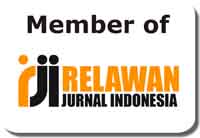Developing Online Learning Assessment Instrument for English Sentence Structure Course during Covid-19 Pandemic
Abstract
Anchored by the need for constructing an online assessment which is mediated by honesty as the character value for grammar mastery among undergraduate students during Covid-19 pandemic, in the present study we developed a test of English Sentence Structure (ESS) situated in an English department of a public university in Malang, East Java, Indonesia. To enact such a purpose, Design-based Research (DBR) was carried out in the study. Findings from the study showcase that the test was valid and reliable, giving it accessible portion for use in the English department. Aside from that, students also opined positively toward the use of the test in measuring their English grammar mastery. Despite these, we found that students’ score in the tryout phase is low affected by their lack of test preparation, inappropriate situated test time, and ineffective teaching and learning enactment. The paper ends with recommendation for future researchers.
Keywords
Full Text:
PDFReferences
Adisutrisno, D. W. (2008). Multiple choice English grammar test items that aid English grammar learning for students of English as a foreign language. K@Ta, 10(1), 36–52. https://doi.org/10.9744/kata.10.1.36-52
Arikunto. (1999). Dasar-dasar Evaluasi Pendidikan Edisi Revisi (Basics of Educational Evaluation Revised Edition). Jakarta: Bumi Angkasa.
Berkowitz, M. W. (2011). What works in values education. International Journal of Educational Research, 50(3), 153–158. http://doi.org/10.1016/j.ijer.2011.07.003
Brown, H. D. (2004). Language assessment: Principles and classroom practices. Longman: Pearson Education, Inc.
Cavallaro, C. J., & Sembiante, S. F. (2021). Facilitating culturally sustaining, functional literacy practices in a middle school ESOL reading program: a design-based research study. Language and Education, 35(2), 160-179.
David, G. (2007). Investigating the performance of alternative types of grammar items. Language Testing, 24, 65–97.
Dembsey, J. M. (2017). Closing the Grammarly® gaps: A study of claims and feedback from an online grammar program. The Writing Center Journal, 36(1), 63–100. http://www.jstor.org/stable/44252638
Djiwandono, P. I. (2016). Character education in content courses: Self-scoring as a means for developing honesty in students. TEFLIN Journal, 27(2), 153-165.
Ellis, A. P., & Ryan, A. M. (2003). Race and cognitive‐ability test performance: The mediating effects of test preparation, test‐taking strategy use and self‐efficacy. Journal of Applied Social Psychology, 33(12), 2607-2629.
Fu, J. S. (2013). ICT in Education: A Critical Literature Review and Its Implications, International Journal of Education and Development using Information and Communication Technology (IJEDICT), 9(1),112-125
Furaidah, F., Saukah, A., & Widiati, U. (2015). Washback of English national examination in the Indonesian context. TEFLIN Journal, 26(1), 36-58.
Galikyan, I., Madyarov, I., & Gasparyan, R. (2019). Student test takers’ and teachers’ perceptions of the TOEFL junior® standard test. ETS Research Report Series, 2019(1), 1–15. https://doi.org/10.1002/ets2.12264
Gall, M. D., Gall, J. P., Borg, W. R. D., & Gall, J. P. (2003). Educational research: An introduction (7th ed.). Pearson Education Inc.
Ismail, S. A. A. (2010). ESP Students’ Views of ESL Grammar Learning. Gema Online Journal of Language Studies, 10(3).
Jazil, S., Manggiasih, L. A., Firdaus, K., Chayani, P. M., & Nely Rahmatika, S. (2020). Students’ attitudes towards the use of Google forms as an online grammar assessment tool. 434(Iconelt 2019), 166–169. https://doi.org/10.2991/assehr.k.200427.033
Johnson, M., & Shaw, S. (2019). What is computer-based testing washback, how can it be evaluated and how can this support practitioner research? Journal of Further and Higher Education, 43(9), 1255–1270. https://doi.org/10.1080/0309877X.2018.1471127
Lang, H. R., & Evans, D. N. (2006). Models, strategies, and methods for effective teaching. Boston: Pearson Education.
Leichsenring, A. (2020). L2 English university teachers’ perceptions on the influence of academic honesty on their teaching & teaching philosophies. Academic Misconduct and Plagiarism, 23.
Mohamadi, Z. (2018). Comparative effect of online summative and formative assessment on EFL student writing ability. Studies in Educational Evaluation, 59, 29–40. https://doi.org/10.1016/j.stueduc.2018.02.003
Mukminin, A., Lestary, P. A., Afifah, Y., Rahmadani, F., & Hendra, R. (2017). The national standardized test policy for English subject: Students' perception. Journal of Education and Learning, 11(2), 200-207.
Nishitani, Atsuko. (2007). Is the test preparation instruction effective in improving scores of grammar section of the TOEIC. Glottodidactica, 32, 139-146.
Rezaee, A. A., Alavi, S. M., & Razzaghifard, P. (2020). Mobile-based dynamic assessment and the development of EFL students' oral fluency. International Journal of Mobile Learning and Organisation, 14(4), 511-532.
Saengboon, S. (2017). English grammar and Thai university students: An insurmountable linguistic battle? English Language Teaching, 10(11), 22. https://doi.org/10.5539/elt.v10n11p22
Safford, K. (2016). Teaching grammar and testing grammar in the English primary school: The impact on teachers and their teaching of the grammar element of the statutory test in spelling, punctuation and grammar (SPaG). Changing English: Studies in Culture and Education, 23(1), 3–21. https://doi.org/10.1080/1358684X.2015.1133766
Spivey, M. F., & McMillan, J. J. (2014). Classroom versus online assessment. Journal of Education for Business, 89(8), 450–456. https://doi.org/10.1080/08832323.2014.937676
Valizadeh, M., & Soltanpour, F. (2020). The flipped pedagogy: Effects on the grammatical competence and writing skill of basic users of English. International Journal of Instruction, 13(3), 761-776.
Windsor, R. J. (2021). The effectiveness of an online grammar study scheme for Chinese undergraduate students. Smart Learning Environments, 8(1). https://doi.org/10.1186/s40561-021-00147-w
Xu, Q., & Liu, J. (2018). A study on the washback effects of the test for English majors (TEM): Implications for testing and teaching reforms. Springer Singapore. https://doi.org/10.1007/978-981-13-1963-1
Yusof, N. A., & Saadon, N. (2012). The effects of web-based language learning on university students’ grammar proficiency. Procedia - Social and Behavioral Sciences, 67(November 2011), 402–408. https://doi.org/10.1016/j.sbspro.2012.11.344.
DOI: http://dx.doi.org/10.31332/lkw.v7i2.3122
Copyright (c) 2021 Emy Sudarwati, Fatimah Fatimah, Yuni Astuti, M. Faruq Ubaidillah

This work is licensed under a Creative Commons Attribution-ShareAlike 4.0 International License.
Publisher:
UPT Pengembangan Bahasa, IAIN Kendari
Jln. Sultan Qaimuddin No. 17 Baruga, Kota Kendari, Sulawesi Tenggara
Website: upb.iainkendari.ac.id
Email: [email protected]


















